
lineage 1: folding cameras

lineage 1: folding cameras |

Semi Olympus 1 with Compur, 1936 - Extremely Rare |
Semi Olympus Model 1 with Compur: 1936 ER***** V<£450
Shutter: Compur Speeded T, B, 1~250th. Lens: Takatiho Tokyo Zuiko f=4.5 x 7.5cm with distinctive double bright ring. The very first camera made by Olympus was based on a 'bought in' upright folding style body with a film format of 4.5cm x 6cm by Proud, Japan, fitted with an imported Compur shutter from Deckel, Germany. The shutter is embelished by a small crescent plate with OLYMPUS engraved thereon covering the original "F Deckel - Munchen" nomenclature. There is anecdotal suggestion in Jean-Paul Francesch's book that Olympus MAY have bought in up to 1000 Deckel shutters. My research might contradict this; it suggests only a few hundred Model 1 were made before the shutters were replaced by Japanese made mechanicals. The only part made by Olympus was the lens, Zuiko 75mm x 4.5 developed in June 1936. Numbering: Lens only. Number made: Research - about 400 |
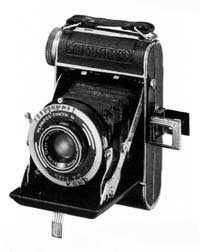
Semi Olympus 1 with Koho shutter, 1937 - Extremely Rare or non-existant |
Semi Olympus Model 1 with Koho: 1937 ER***** V<£450
Shutter: Koho Speeded T, B, 1~150th. Lens: Takatiho Tokyo Zuiko f=4.5 x 7.5cm (Image courtesy of Olympus, Japan) Identical to the Model 1 except as the name suggests this folder is fitted with the Japanese shutter by Koho. In an article by Eichii Sakurai in VisionAge he discussed the development of the Deckel shutter from Compound which relies on air pressure for the braking train to the later Compur/Auto-Compur which has a gear train brake. The article states 'The Deckel "Compound Shutter", used initially, utilized air resistance as its brake.' I misinterpreted this in my last research update, so any previous reference to air braked shutters must be ignored. The new German Prontor shutter had by then reached the market and company shutter makers were asked to design a new shutter along the lines of the Prontor. This was eventually to become the KOHO shutter though it may have made a brief appearance as the LAUREL shutter (see below). The Semi-Olympus shown here is from the Olympus archives. My research indicates that this probably a composite camera made up at a later date as the lens number is well out of sequence. Numbering: Lens only. Number made: Not known; possibly/probably not made. There is a suggestion based on a mid-1937 advert that Olympus also fitted the Proud body with a RULEX shutter. This may have been the intention for latter batches of Proud bodies, but no authenticated evidence exists that it actually occurred, no mock-up or advert image as with the Semi 2 below. But, the shutter issue is confusing. The Compur version exists. Evidence for the Koho version indicates a composite. I have seen a Rulex version but am not persuaded of its authenticity as its serial number places it in the earliest Compur period, too early to fit any subsequent 1937 theory. I also have some difficulty with the suggestion that Olympus' own historical account of its founding date for camera manufacture may be inaccurate; I believe 1936 is the release date for the Semi-Olympus. |

Semi Olympus 2 with Laurel shutter, 1937 probable prototype. From an Olympus held contemporary advert. |
Semi Olympus Model 2 - First Model/Prototype: 1937; V n/a
Shutter: Laurel marked Olympus-Tokyo-N, Speed range unknown but probably T, B, 1~150th. Lens: Takatiho Tokyo Zuiko f=4.5 x 7.5cm The second incarnation from Olympus shows a complete turn around from their original concept. The body has been redesigned and now presents in the horizontal rather than the upright. For such a large body, strangely the film format remains the same at 4.5cm x 6cm. Fitted with a Newton style tube finder placed at the users far left it looks cumbersome to use. The door release mechanism is centrally fitted above the bellows. I am pretty sure this is an illustration of a mock-up or a prototype and this particular style/specification was not commercially made. Numbering (presumed): Lens and body (wind on knob). Number made of this variant: probably none. [Confusion reigns around shutter names. LAUREL was made by Takachiho but was renamed KOHO, Laurel being registered elsewhere. Some contemporary shutter and camera names were set to confuse. Other parts of Japan's camera industry tried to reflect more famous German brands in their own names]. |
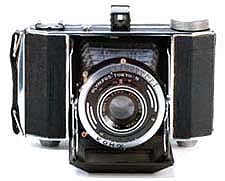
Semi Olympus 2 with Koho shutter, 1937/38 - Rare |
Semi Olympus Model 2 - Second/Production Model: 1937-1938 VR**** V<£200
Shutter: Koho marked Olympus Tokyo N, Speeded T, B, 1~150th. Lens: Takatiho Tokyo Zuiko f=4.5 x 7.5cm with distinctive double bright ring. The production version of Semi model 2 has the same elongated body but the designer has moved Newton finder to be centrally placed above the lens and the moved the door release mechanism to the users right side. This makes the production camera more usable than the prototype. It has the same film format at 4.5cm x 6cm as the Semi 1. This body manufacture caused Olympus problems and it was eventually abandoned in favour of a more 'modern' design. Numbering: Lens and body (wind on knob). Number made: Research - around 4000 [There is a second version of the Semi 2 that is fitted with an improved KOHO shutter with top speed of 1/200th. These appear quite late in the sequence towards the end of 1938 with serial numbers above 6000.] |
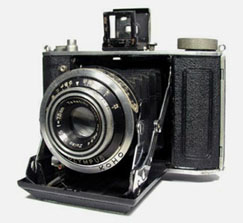
Olympus Six 1 with Koho shutter & 4.5 lens, 1939 - Very Rare |
Olympus Six 1: 1939 VR*** V<£175
Shutter: Koho speeded 1~200th + B & T. Lens: Takatiho Tokyo Zuiko f=4.5 x 7.5cm with distinctive double bright ring. Following some criticism about the format size of the Semi 2, Eichii Sakurai set about redesigning the camera. The result was the Olympus Six, a true 6cm x 6cm folder (with a 4.5cm x 6cm mask) and flip up Galilean finder. This was more strongly copied from the Ikonta Six and made from pressed steel plates giving more strength. Of the two versions released, this one sports a Zuiko f=4.5 lens. All pre-war Olympus cameras are pretty rare but this f=4.5 version of the black six is especially so. Numbering: Lens and body (wind on knob). Number made: unknown.
|

Olympus Six 1 with Koho shutter & 3,5 lens, 1939 - Very Rare |
Olympus Six 1: 1939 VR*** V<£150
The second version of the pre-war black Olympus Six is identical in every respect to the above except it is fitted with a new 5 element 75mm x f=3.5 Takatiho Tokyo Zuiko lens. This version is illustrated here. All pre-war Olympus cameras are pretty rare; the f=3.5 version of the black six is slightly less rare than the 4,5 version. Numbering: Lens and body (wind on knob). Number made: unknown. Accurate dating of early cameras is almost impossible from body construction. The best indicator of progression is via lens number sequence. Lens counters ran from the first Zuiko made in 1936 number 1000, in several sequences. |
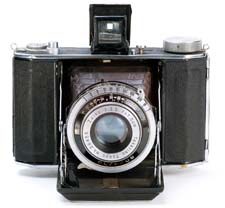
Olympus Six 1 with new shutter, 1940 - Very Rare |
Olympus Six 1 model 3 with improved shutter: 1940 VR**** V<£175
In the same year Olympus released a third model of the Six, identical to the first model but sporting an improved shutter range 1~300th + T & B. The shutter is not by Koho and its dress ring is now anonymous. The lens however is still marked Takatiho Tokyo. In my many years of collecting I have only seen two examples of this type of Olympus Six. Numbering: Lens & body. Number made: unknown. Dual format 6cm x 6cm or 4.5cm x 6cm. There is also a version fitted with a Wester shutter; I have one in my collection but regarded it with suspicion until I saw a second example. I am now sure an 'official' Wester version exists.
|
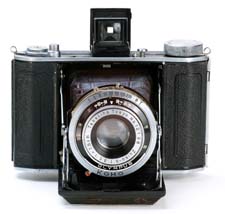
Olympus Super Six 1945 - Very Rare |
Olympus Super Six with improved 5 element in 3 group optics: 1945 VR**** V<£200
As the war progressed the glass previously used in the construction of Zuiko lenses, German Schott glass became unavailable. Not to let this get in the way of production Eichii Sakurai redisigned the optics to use domestically available 'optic' grade glass. I suspect that was why the number of elements was increased to 5. All such cameras bear the designation Zuiko S on the lens dress ring. There are some contemporary sixes which also have SUPER OLYMPUS branded into the leatherette on the rear door. It is assumed that the S designation also equates to these Super Olympus Sixes. Numbering: Lens & body. Number made: unknown.
|

Olympus Six Immediate Post War. 1946 - Rare |
Olympus Six Post War Versions: 1946~47 R*** V<£140
There is much confusion as to the exact timings of many of the early folders from Olympus but more so during the war and immediate post war years. It is known that the Koho factory was completely destroyed in 1945 but Olympus did have a stock of Koho shutters at the Suwa plant. However there is no definitive schedule of production. Certainly there were still cameras being made and one identifier of post war models is the cover material that appears to be embossed paper, quite heavily grained which adorns some models and is unlike anything prior. Numbering: Lens & body. Number made: unknown.
|

Olympus Chrome Six I & II. 1948 - Rare |
Olympus Chrome Six. 1948 R*** V<£150 (2.8 version +5%)
The prototype for the Chrome 6 was put together in 1947. Moving away from pressed steel plates the new design embraced die casting for accuracy and strength. In a return to the look of the Semi model 2, the new model boasts a fixed Newton finder and a finely made pressed accessory shoe fitted to an aventurine-chrome plated top plate. It is thfine shoe feature that marks out the first Chrome 6 from all that follow and is a sure way for collectors to recognise the model. Two were made; Chrome Six I - with f=3.5 lens and Chrome Six II with f=2.8 lens. Numbering: Lens & body. Number made: unknown.
|
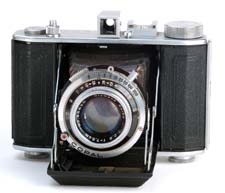
Olympus Chrome Six III. 1950 - Quite Rare |
Olympus Chrome Six III models A & B. 1950 QR*** V<£90 (2.8 version +5%)
Building on the sucess of model 1 the new series 3 boasts a newly designed film tensioning device built into the wind-on mechanism. It is a novel idea said to aid film plane stability. In addition the fine pressed shoe of the previous model is dropped for a new heavy duty solid aluminium machined shoe that is seen on all subsequent folding and other cameras. Numbering: Lens & body. Number made: unknown.
|
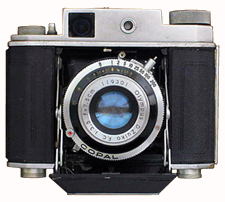
Olympus Chrome Six IVA. 1954 - Rare |
Olympus Chrome Six IV models A & B. 1954 R**** V<£160
1954 sees the first folders from Olympus fitted with a coupled (to the viewfinder image) rangefinder. For the next two years the folding range are graced by a top plate housing for both viewfinder and rangefinder. In all 6 models will appear in less than 2 years as folding cameras lose out to the new breed of camera - compacts. However, as always, short run and unpopular cameras mean serious challenges for collectors. This range of 'topped' folders is very difficult to complete. Following the now established tradition models A & B feature f=3.5 and f=2.8 lenses, respectively. Numbering: Lens and body. Number made: unknown. |
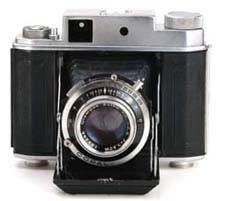
Olympus Chrome Six IVB. 1954 - Rare |
Shown here is the slightly rarer brighter aperture 2.8 model. There is virtually no difference apart from the lens. Earlier examples had a tiny dress ring around the rangefinder pupil (as shown above). |

Olympus Chrome Six V. 1955 - Rare |
Olympus Chrome Six V models A & B. 1955 R**** V<£140
Continuing the 'topped' look the next offering no longer features an in-built coupled rangefinder. The design strategy is now aimed at a smooth top plate. To achieve this the winding knob is deleted and a short wind-on lever is added, projecting from the top plate to the rear. A fancy shutter release button is also added and a viewfinder format mask is provided, switchable from the rear of the top plate rear. Also featured is a focus compensation marker on the focus ring. Following the now established tradition models A & B feature f=3.5 and f=2.8 lenses. Both models have the new door clasp. Numbering: Lens & body. Number made: unknown.
|
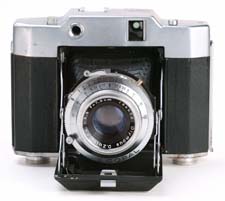
Olympus Chrome Six RIIA. 1955 - Very Rare |
Olympus Chrome Six RIIA model A. 1955 VR**** V<£200
This is the end of the line for Olympus folding cameras. After some 20 years of production folders are no longer popular as the 35mm compact is set to take over the world. The two death throw cameras in the series are dealt with separately as they are a strange 'pair'. Illustrated here is Model A with the f=3.5 lens. It is identical to the previous incarnation except for the addition of the rangefinder and a black plastic shutter release button. The focus compensation 'hairlike' line is present on the focus ring. Model A has the new door clasp. Numbering: Lens & body. Number made: unknown.
|

Olympus Chrome Six RIIB. 1955 - Very Rare |
Olympus Chrome Six RIIB model B. 1955 VR**** V<£200
I've chosen to illustrate the two versions separately as they seem, on the face of it, two different models. Collectors need to see the difference. Model B is, as usual, fitted with the F=2.8 lens. But note the DoF ring is black as opposed to machined aluminium; the top-plate is not as deep and the shutter button reverts to the older Chrome Six III type. The body and lens appears to be from old stock of the Chrome Six IIIB with the more modern top-plate and winding arrangements grafted on. I suppose this makes good housekeeping sense - to get rid of the old bodies while the cameras are still selling. Model B has the older door release. Numbering: Lens & body. Number made: unknown.
If you have any further information that may add to this list or any images of examples not illustrated here please contact the author who will be delighted to hear from you.
|
|
HOME |
INTRO |
BOOKS |
OLYMPUS CIRCLE |
QUEST |
TOC MEMBERS |
GALLERIES
|
| Posted 2004/12/12 | Copyright © 2004 John Foster |